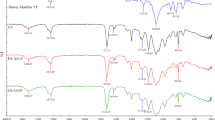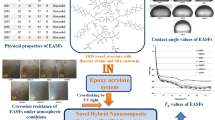Abstract
A coating precursor containing both acrylate functionality and trimethoxysilane functionality was produced by reacting bisphenol-A glycerolate diacrylate with 3-isocyanatopropyltimethoxysilane. With this precursor, two different crosslinked networks can be produced. A polyacrylate network can be produced using a radiation-cure mechanism while a polysiloxane network can be produced by hydrolysis and condensation reactions involving the trimethoxysilane groups. The objective of the study was to determine the utility of this dual-cure system for generating rapid-cure coatings for corrosion protection. Coating properties were determined as a function of cure conditions. The results of the study showed that the formation of siloxane crosslinks was significantly hindered by the crosslinked network induced by the UV-curing process. Even though the overall conversion of trimethoxysilane groups to siloxane crosslinks was relatively low, coating barrier properties were significantly enhanced and coating free volume reduced. At ambient conditions, additional crosslinking occurring through siloxane bond formation increased within the first 4 days after UV-curing. Beyond this period, siloxane bond formation remained unchanged as did coating properties.












Similar content being viewed by others
References
Stearns, DM, Wetterhahn, KE, “Intermediates Produced in the Reaction of Chromium(VI) with Dehydroascorbate Cause Single-Strand Breaks in Plasmid DNA.” Chem. Res. Toxicol., 10 271–278 (1997)
Faisal, M, Hasnain, S, “Hazardous Impact of Chromium on Environment and Its Appropriate Remediation.” J. Pharmacol. Toxicol., 1 (3) 248–258 (2006)
Poznyak, SK, Zheludkevich, ML, Raps, D, Gammel, F, Yasakau, KA, Ferreira, MGS, “Preparation and Corrosion Protective Properties of Nanostructured Titania-Containing Hybrid Sol–Gel Coatings on AA2024.” Prog. Org. Coat., 62 (2) 226–235 (2008)
Moutarlier, V, Neveu, B, Gigandet, MP, “Evolution of Corrosion Protection for Sol–Gel Coatings Doped with Inorganic Inhibitors.” Surf. Coat. Technol., 202 (10) 2052–2058 (2008)
Li, L, Pi, P, Wen, X, Cheng, J, Yang, Z, “Optimization of Sol–Gel Coatings on the Surface of Aluminum Pigments for Corrosion Protection.” Corros. Sci., 50 (3) 795–803 (2008)
Lamaka, SV, Montemor, MF, Galio, AF, Zheludkevich, ML, Trindade, C, Dick, LF, Ferreira, MGS, “Novel Hybrid Sol–Gel Coatings for Corrosion Protection of AZ31B Magnesium Alloy.” Electrochim. Acta, 53 (14) 4773–4783 (2008)
Wang, H, Akid, R, “Encapsulated Cerium Nitrate Inhibitors to Provide High-Performance Anti-Corrosion Sol–Gel Coatings on Mild Steel.” Corros. Sci., 50 (4) 1142–1148 (2008)
Checmanowski, JG, Szczygiel, B, “Effect of Nanosilica Type on Protective Properties of Composite Ceramic Coatings Deposited on Steel 316L by Sol–Gel Technique.” J. Non-Cryst. Solids, 354 (15–16) 1786–1795 (2008)
Tamar, Y, Mandler, D, “Corrosion Inhibition of Magnesium by Combined Zirconia Silica Sol–Gel Films.” Electrochim. Acta, 53 (6) 5118–5127 (2008)
Andreatta, F, Aldighieri, P, Paussa, L, Di Maggio, R, Rossi, S, Fedrizzi, L, “Electrochemical Behaviour of ZrO2 Sol–Gel Pre-Treatments on AA6060 Aluminium Alloy.” Electrochim. Acta, 52 (27) 7545–7555 (2007)
Bayramoglu, G, Kahraman, MV, Kayaman-Apohan, N, Guengoer, A, “Synthesis and Characterization of UV-Curable Dual Hybrid Oligomers Based on Epoxy Acrylate Containing Pendant Alkoxysilane Groups.” Prog. Org. Coat., 57 (1) 50–55 (2006)
Orbey, N, “UV-Curable Aerospace and Aircraft Coatings.” RADTECH Rep., July/August 43–51 (2006)
Johnson, JA, Bliss, CQ, “UV-Cure Military Aerospace Coatings—An Emerging Market.” RADTECH Rep., July/August 21–25 (2006)
Karataş, S, Kızılkaya, C, Kayaman-Apohan, N, Güngör, A, “Preparation and Characterization of Sol–Gel Derived UV-Curable Organo-Silica-Titania Hybrid Coatings.” Prog. Org. Coat., 60 (2) 140–147 (2007)
Xu, J, Pang, W, Shi, W, “Synthesis of UV-Curable Organic–Inorganic Hybrid Urethane Acrylates and Properties of Cured Films.” Thin Solid Films, 514 (1–2) 69–75 (2006)
Jean, YC, Schrader, DM, “Positron and Positronium Chemistry.” In: Schrader, DM, Jean, YC (eds.) Studies in Physical and Theoretical Chemistry, p. 91. Elsevier, Amsterdam, 1988
Djourelov, N, Misheva, M, “Source Correction in Positron Annihilation Lifetime Spectroscopy.” J. Phys. Condens. Matter, 8 (12) 2081–2087 (1996)
He, J, Bahr, J, Chisholm, BJ, Li, J, Chen, Z, Balbyshev, SN, Bonitz, V, Bierwagen, GP, “Combinatorial Materials Research Applied to the Development of New Surface Coatings X: A High-Throughput Electrochemical Impedance Spectroscopy Method for Screening Organic Coatings for Corrosion Inhibition.” J. Comb. Chem., 10 (5) 704–713 (2008)
Oliver, WC, Pharr, GM, “An Improved Technique for Determining Hardness and Elastic Modulus Using Load and Displacement Sensing Indentation Experiments.” J. Mater. Res., 7 (6) 1564–1583 (1992)
Schrader, B, Infrared and Raman Spectroscopy. VCH, New York, 1995
Zheludkevich, ML, Salvado, IM, Ferreira, MGS, “Sol–Gel Coatings for Corrosion Protection of Metals.” J. Mater. Chem., 15 (48) 5099–5111 (2005)
Perutz, S, Wang, J, Ober, CK, Kramer, EJ, “Adhesion Between Hydrolyzed Surfaces of PDMS Networks.” Polym. Prepr., 37 (2) 45–46 (1996)
Acknowledgment
The authors gratefully acknowledge financial support from the Air Force Research Laboratory under Grant FA8650-04-1-5045.
Author information
Authors and Affiliations
Corresponding author
Rights and permissions
About this article
Cite this article
He, J., Chisholm, B.J., Mayo, B.A. et al. Hybrid organic/inorganic coatings produced using a dual-cure mechanism. J Coat Technol Res 9, 423–431 (2012). https://doi.org/10.1007/s11998-011-9389-z
Published:
Issue Date:
DOI: https://doi.org/10.1007/s11998-011-9389-z




